Optimizing Airfoil Aerodynamic Characteristics by Using Proposed CSA-KJ Method
Abstract
:Featured Application
Abstract
1. Introduction
2. Aerodynamic Optimization Method: CSA-KJ
2.1. Objective Function of CSA-KJ Method
2.2. Airfoil Optimization Process of CSA-KJ Method
- (1)
- Each cuckoo lays only one egg at a time, and randomly selects a nest for storage.
- (2)
- During the process of nest hunting, the nest with the best eggs will be preserved for the next generation.
- (3)
- The number of available nests is fixed, and the probability of finding foreign eggs in a nest is , [0,1]. If foreign birds’ eggs are found, the owner of the nest will build a new nest.
- Step 1:
- Define objective function , and select in Equation (7) as the objective function of CSA-KJ aerodynamic optimization method.
- Step 2:
- Use the NACA4412 airfoil as the object of comparison in function initialization stage of this work and obtain coordinate points, respectively, on the upper and lower profile line of NACA4412 airfoil and fit the coordinate points at the upper and lower lines of the airfoil with fourth-order nonconstant polynomial function. Obtain two fitting curves and set 200 initial positions randomly on the fitting curve.
- Step 3:
- Set population size, dimension of problem and maximum number of iterations. In this work, population size n is 200. Problem dimension is 2, here . Upper limit of optimization iteration set to .
- Step 4:
- Generate or update the position of each individual in the group.
- Step 5:
- Calculate the objective function value of each nest position, and then obtain the current optimal function value according to Equation (7).
- Step 6:
- Record the value of the last generation optimal function and update the position and status of other bird nests with Equation (8).
- Step 7:
- Compare the current position function value with the previous generation optimal function value. If it is better, change the current optimal value.
- Step 8:
- Gain the processed airfoil when the calculated airfoil lift is greater than the set maximum lift or the number of iterations is greater than, otherwise, continue to return the Step 4.
- Step 9:
- Obtain the maximum lift and the coordinate point corresponding to the maximum lift and use the fourth-order non-constant function to fit the parameters of the upper and lower airfoil coordinate points. Finally, generate the smooth airfoil and establish the aerodynamic analysis model of the airfoil.
3. Example Analysis and Simulation
3.1. NACA4412 Airfoil Optimization and Grid Division
3.2. CFD Simulations
3.3. Reliability Verification of CSA-KJ Method
4. Aerodynamic Characteristics of CSA-KJ4412 Airfoil
4.1. Variation of Lift-Drag Ratio with Incoming Wind Speed
4.2. Variation Curve of Pressure Difference
5. Conclusions
- (1)
- The CSA-KJ method better improves the aerodynamic characteristics of the airfoil, whose profile described by the fourth-order constant-free polynomial function is relatively smooth. The average lift-drag ratio of CSA-KJ4412 increases by 4.53% compared with that of NACA4412.
- (2)
- At different angles of attack, the lift-drag ratio of CSA-KJ4412 at each incoming wind speed is higher than that of the original NACA4412. The difference in lift-drag ratio between the two airfoils uninterruptedly increases with the increase of incoming wind speed.
- (3)
- When the angle of attack is not more than 15°, the pressure difference distribution of CSA-KJ4412 is better than that of NACA4412, and the average pressure difference at each calculated attack angle is higher.
- (4)
- The CSA-KJ4412 airfoil has a better effect in the range of small angle of attack. The CSA-KJ method can be popularized and applied to the optimization of airfoils such as wings, aircraft engine turbines and wind turbine blades.
Author Contributions
Funding
Institutional Review Board Statement
Informed Consent Statement
Data Availability Statement
Conflicts of Interest
References
- Sharma, P.; Gupta, B.; Pandey, M.; Sharma, A.K.; Mishra, R.N. Recent advancements in optimization methods for wind turbine airfoil design: A review. Mater. Today Proc. 2021, 47, 6556–6563. [Google Scholar] [CrossRef]
- Gui, X.; Xue, H.; Su, S.; Hu, Z.; Xu, Y. Study on aerodynamic performance of mine air duct horizontal axis wind turbine based on breeze power generation. Energy Sci. Eng. 2022, 10, 1132–1152. [Google Scholar] [CrossRef]
- Chitransh, A.; Kaur, S. Analysis of Airfoil for Horizontal axis Wind Turbine Blade. In Proceedings of the 2022 3rd International Conference for Emerging Technology (INCET), Belgaum, India, 27–29 May 2022; pp. 1–6. [Google Scholar] [CrossRef]
- Liu, T. Evolutionary understanding of airfoil lift. Adv. Aerodyn. 2021, 3, 37. [Google Scholar] [CrossRef]
- Spall, R.; Hodson, J. Educational Results Obtained Using an Improved Two-Dimensional Panel Method Code in Undergraduate Fluid Dynamics and Aerodynamics Courses. In Proceedings of the ASME Fluids Engineering Division Summer Meeting, Waikoloa, Hawaii, USA, 30 July–3 August 2017. [Google Scholar] [CrossRef]
- Gutierrez, E.; Quinn, D.B.; Chin, D.D.; Lentink, D. Lift calculations based on accepted wake models for animal flight are inconsistent and sensitive to vortex dynamics. Bioinspiration Biomim. 2016, 12, 016004. [Google Scholar] [CrossRef]
- Wang, S.; He, G.; Liu, T. Estimating lift from wake velocity data in flapping flight. J. Fluid Mech. 2019, 868, 501–537. [Google Scholar] [CrossRef] [Green Version]
- van Veen, W.G.; van Leeuwen, J.L.; Muijres, F.T. A chordwise offset of the wing-pitch axis enhances rotational aerodynamic forces on insect wings: A numerical study. J. R. Soc. Interface 2019, 16, 20190118. [Google Scholar] [CrossRef]
- Zhuang, K.Y.; Gao, C.D.; Li, Z.; Yan, D.L.; Fu, X.Q. Dynamic analyses of the Hydro-Turbine generator shafting system considering the hydraulic instability. Energies 2018, 11, 2862. [Google Scholar] [CrossRef] [Green Version]
- De Tavernier, D.; Ferreira, C.; Bussel, G. Airfoil optimisation for vertical-axis wind turbines with variable pitch. Wind. Energy 2019, 22, 547–562. [Google Scholar] [CrossRef]
- Akram, T.; Kim, M.-H. CFD Analysis and Shape Optimization of Airfoils Using Class Shape Transformation and Genetic Algorithm—Part I. Appl. Sci. 2021, 11, 3791. [Google Scholar] [CrossRef]
- Farhadi, A.; Rad, E.G.; Emdad, H. Aerodynamic Multi-Parameter Optimization of NACA0012 Airfoil Using Suction/Blowing Jet Technique. Arab. J. Sci. Eng. 2016, 42, 1727–1735. [Google Scholar] [CrossRef]
- Echavarria, C.; Hoyos, J.D.; Jimenez, J.H.; Suarez, G.; Saldarriaga, A. Optimal airfoil design through particle swarm optimization fed by CFD and XFOIL. J. Braz. Soc. Mech. Sci. Eng. 2022, 44, 561. [Google Scholar] [CrossRef]
- Kotinis, M.; Kulkarni, A. Multi-objective shape optimization of transonic airfoil sections using swarm intelligence and surrogate models. Struct. Multidiscip. Optim. 2011, 45, 747–758. [Google Scholar] [CrossRef]
- Cheng, C.; Xu, P.-F.; Cheng, H.; Ding, Y.; Zheng, J.; Ge, T.; Sun, D.; Xu, J. Ensemble learning approach based on stacking for unmanned surface vehicle’s dynamics. Ocean Eng. 2020, 207, 107388. [Google Scholar] [CrossRef]
- Tran-Ngoc, H.; Khatir, S.; Ho-Khac, H.; De Roeck, G.; Bui-Tien, T.; Wahab, M.A. Efficient Artificial neural networks based on a hybrid metaheuristic optimization algorithm for damage detection in laminated composite structures. Compos. Struct. 2020, 262, 113339. [Google Scholar] [CrossRef]
- Sumathi, R.; Venkatesulu, M. Segmenting MRI Brain Tumor Images Using Modified Cuckoo Search Optimization with Morphological Reconstruction Filters. In Proceedings of the IEEE International Conference on Intelligent Techniques in Control, Optimization and Signal Processing (INCOS), Tamilnadu, India, 11–13 April 2019; pp. 1–4. [Google Scholar] [CrossRef]
- Li, D.; Xu, S.; Qi, X.; Wang, N.; Cao, X. Variable step size adaptive cuckoo search optimization algorithm for phase diversity. Appl. Opt. 2018, 57, 8212–8219. [Google Scholar] [CrossRef]
- Liu, J.; Wang, D.; Luo, S. An Effective Constraint-Handling Improved Cuckoo Search Algorithm and Its Application in Aerodynamic Shape Optimization. IEEE Access 2020, 8, 139121–139142. [Google Scholar] [CrossRef]
- Cheng, J.; Wang, L.; Xiong, Y. An improved cuckoo search algorithm and its application in vibration fault diagnosis for a hydroelectric generating unit. Eng. Optim. 2017, 50, 1593–1608. [Google Scholar] [CrossRef]
- Rizzo, F.; D’Alessandro, V.; Montelpare, S.; Giammichele, L. Computational study of a bluff body aerodynamics: Impact of the laminar-to-turbulent transition modelling. Int. J. Mech. Sci. 2020, 178, 105620. [Google Scholar] [CrossRef]
- Kabir, A.; Akib, Y.M.; Hafiz, A.; Islam, M. Comparison between two Kline–Fogleman Modified (KFm) based Stepped Airfoils for better Aerodynamic Performance. In Proceedings of the 2019 2nd International Conference on Innovation in Engineering and Technology (ICIET), Dhaka, Bangladesh, 23–24 December 2019; pp. 1–5. [Google Scholar] [CrossRef]
- Kulkarni, D.S.; Rajani, B.N. Numerical Analysis of High Reynolds Number Effects on the Performance of GAW-1 Airfoil. In Design and Development of Aerospace Vehicles and Propulsion Systems; Springer: Singapore, 2021; pp. 425–432. [Google Scholar] [CrossRef]
- Yang, L.; Zhang, G. Analysis of Influence of Different Parameters on Numerical Simulation of NACA0012 Incompressible External Flow Field under High Reynolds Numbers. Appl. Sci. 2022, 12, 416. [Google Scholar] [CrossRef]
- Pellerin, N.; Leclaire, S.; Reggio, M. An implementation of the Spalart–Allmaras turbulence model in a multi-domain lattice Boltzmann method for solving turbulent airfoil flows. Comput. Math. Appl. 2015, 70, 3001–3018. [Google Scholar] [CrossRef]
- Rogowski, K.; Hansen, M.O.L.; Bangga, G. Performance Analysis of a H-Darrieus Wind Turbine for a Series of 4-Digit NACA Airfoils. Energies 2020, 13, 3196. [Google Scholar] [CrossRef]
- Sanei, M.; Razaghi, R. Numerical investigation of three turbulence simulation models for S809 wind turbine airfoil. Proc. Inst. Mech. Eng. Part A J. Power Energy 2018, 232, 1037–1048. [Google Scholar] [CrossRef]
- Wang, Q.; Zhao, Q. Unsteady aerodynamic characteristics investigation of rotor airfoil under variational freestream velocity. Aerosp. Sci. Technol. 2016, 58, 82–91. [Google Scholar] [CrossRef]
- Li, J.; Xu, Y.; Wu, Z. Kutta-Joukowski force expression for viscous flow. Sci. China Physics, Mech. Astron. 2014, 58, 90–94. [Google Scholar] [CrossRef]
- Yang, X.-S. Cuckoo Search and Firefly Algorithm: Overview and Analysis. Eng. Optim. 2013, 516, 1–26. [Google Scholar] [CrossRef]
- Jacobs, E.N.; Sherman, A. Airfoil section characteristics as affected by variations of the Reynolds number. NACA Tech. Rep. 1937, 586, 227–267. [Google Scholar] [CrossRef]
- Cai, D.; Xie, J.S.; Zhang, G.L. Research of optimization design about airfoil with multi-objective simulation. Mech. Res. Appl. 2013, 26, 49–51. [Google Scholar] [CrossRef]
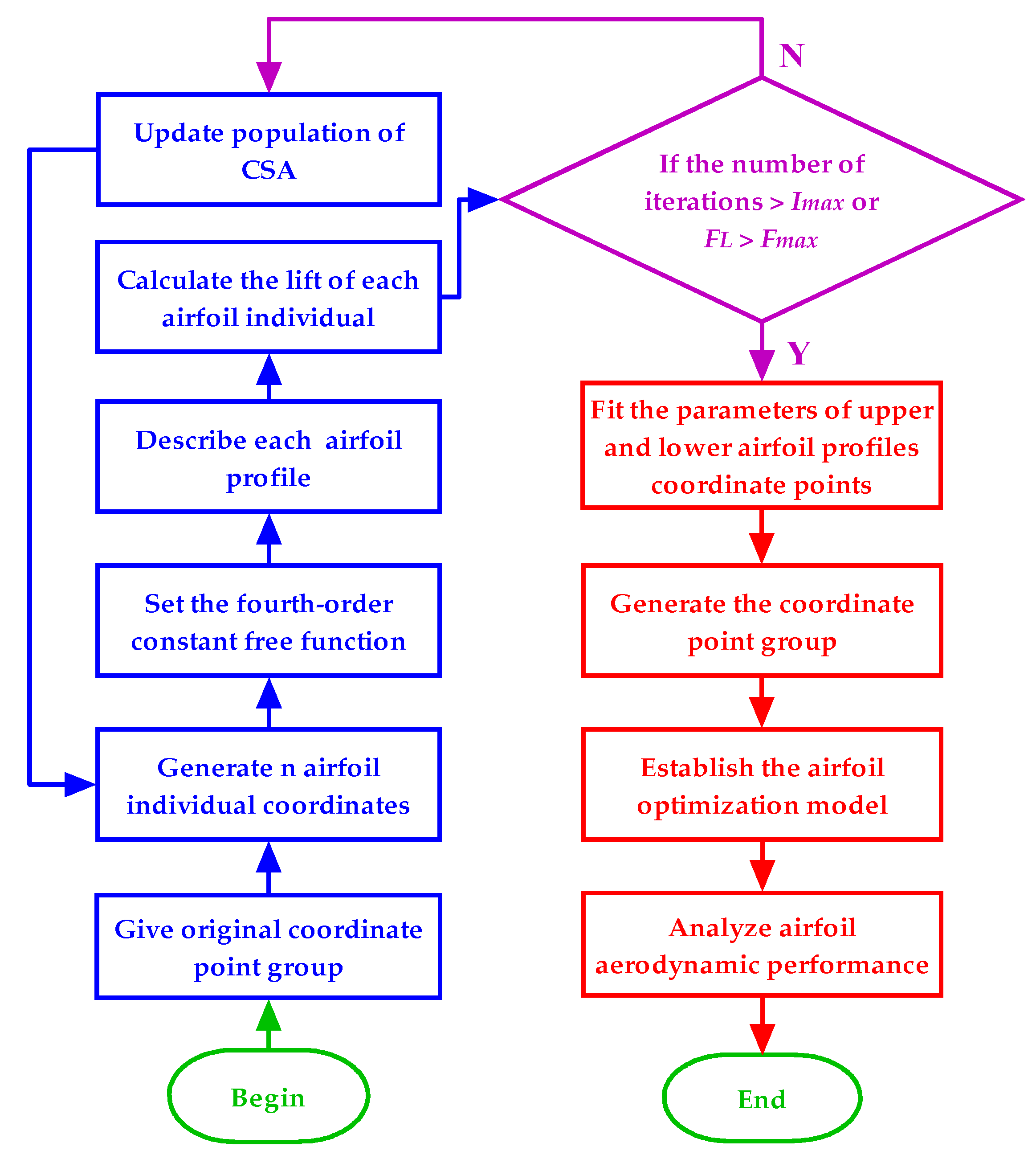


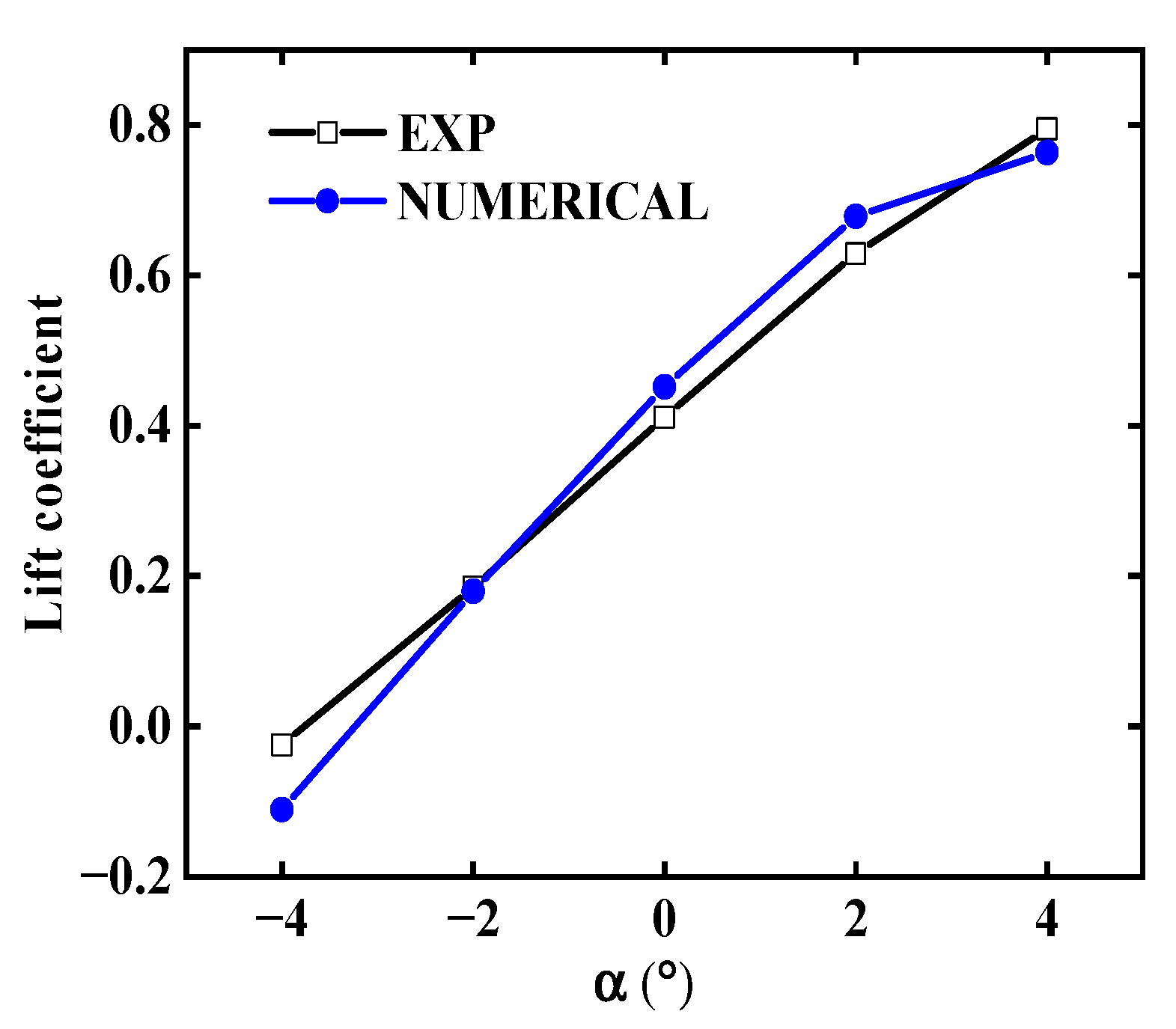


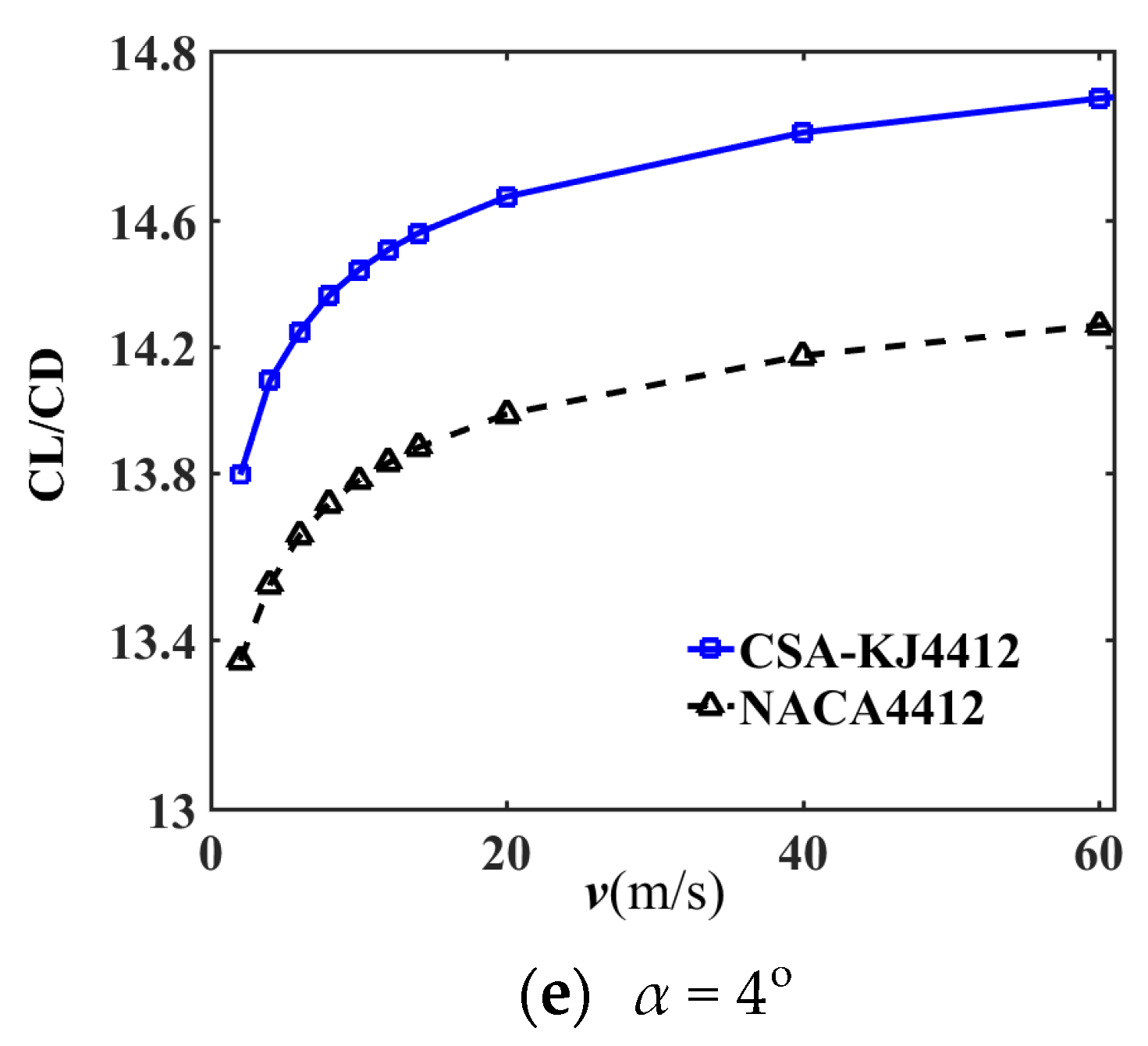
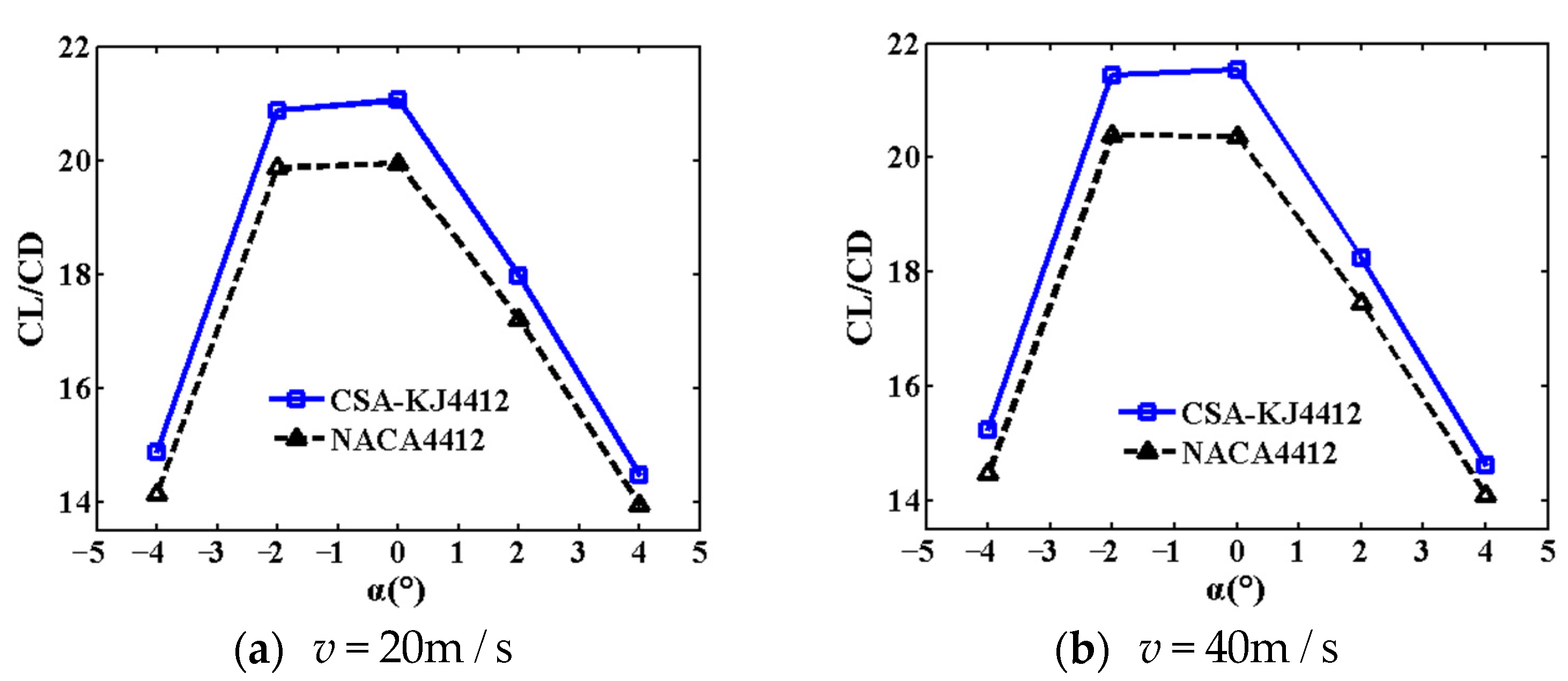
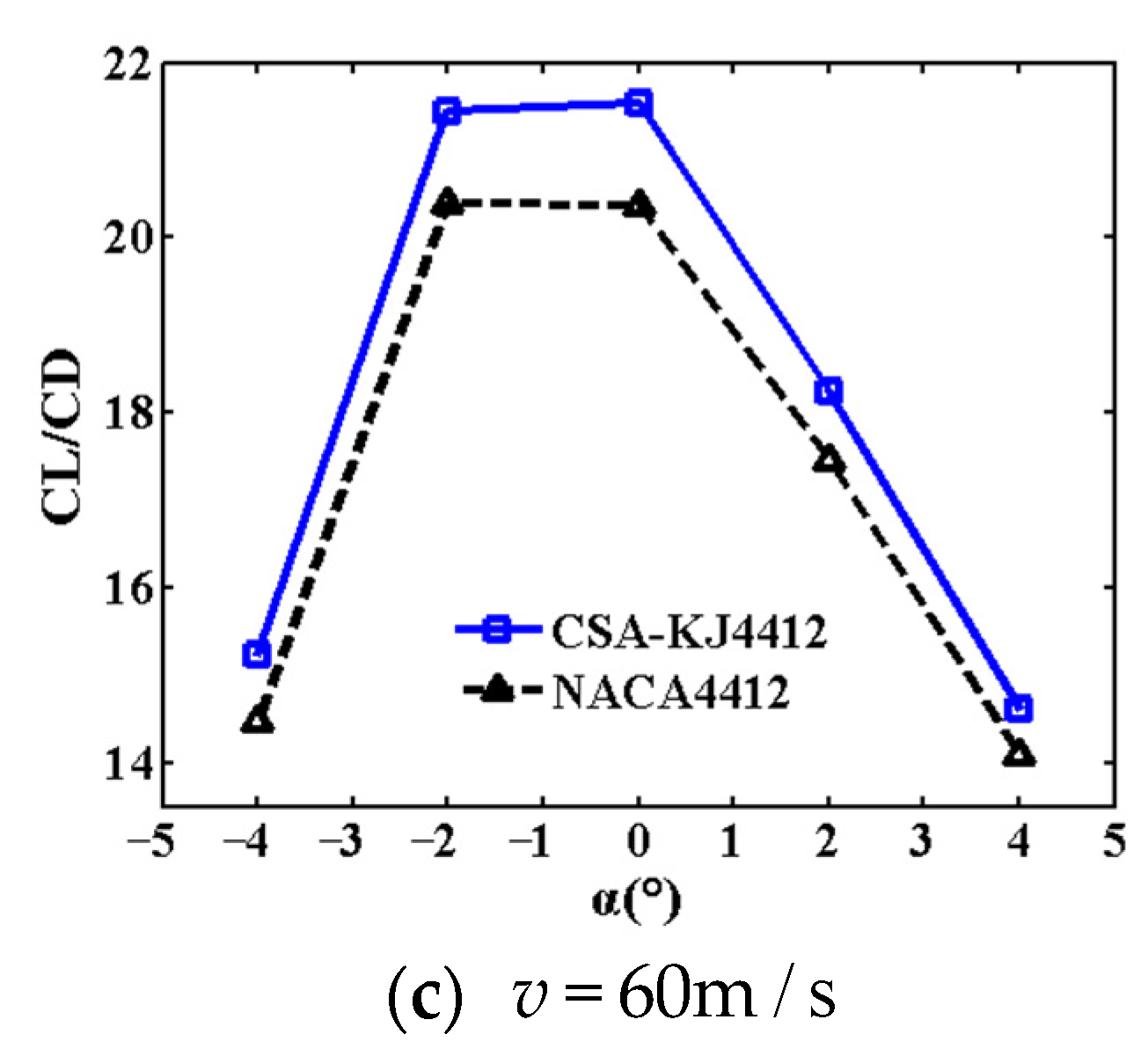
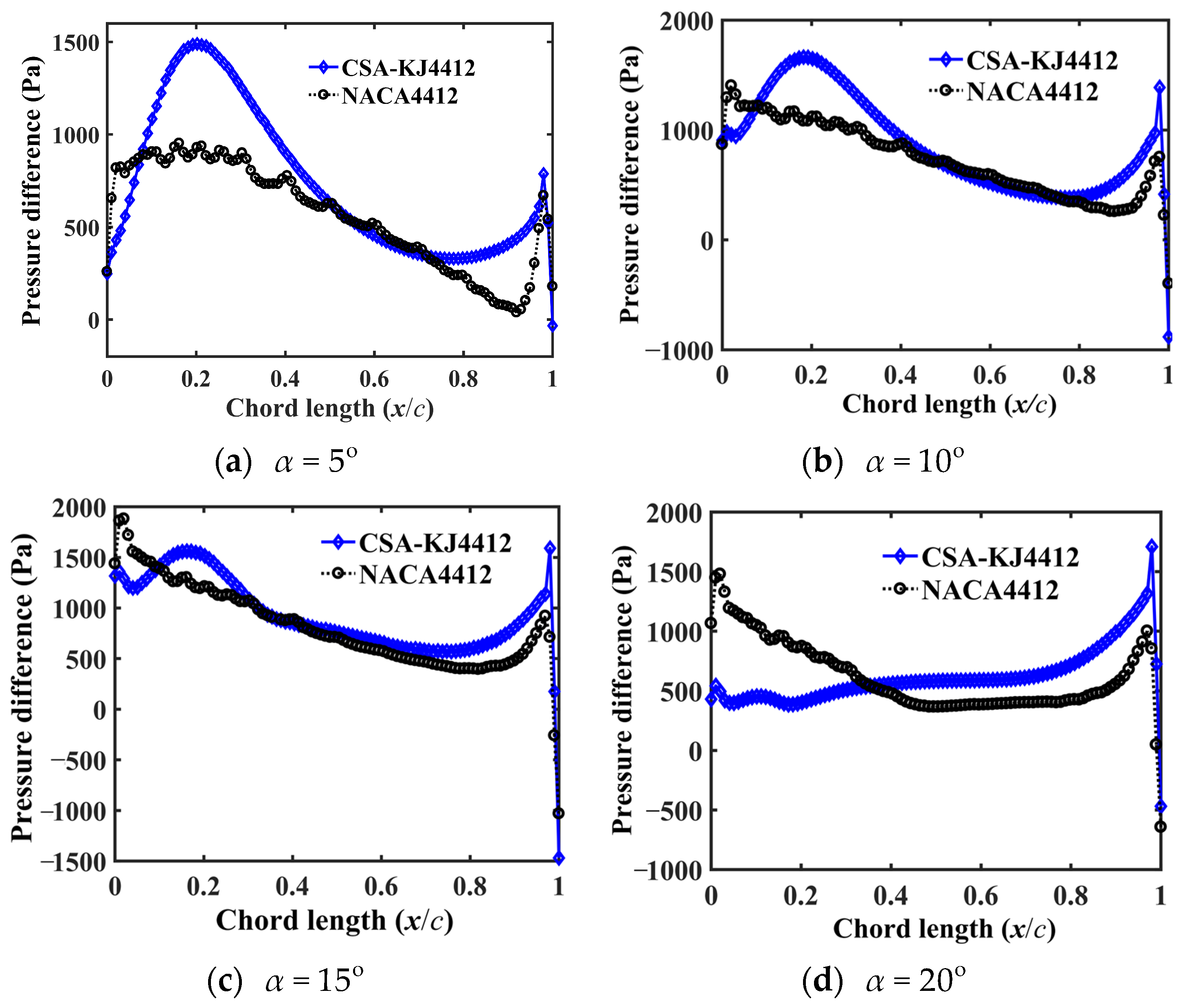
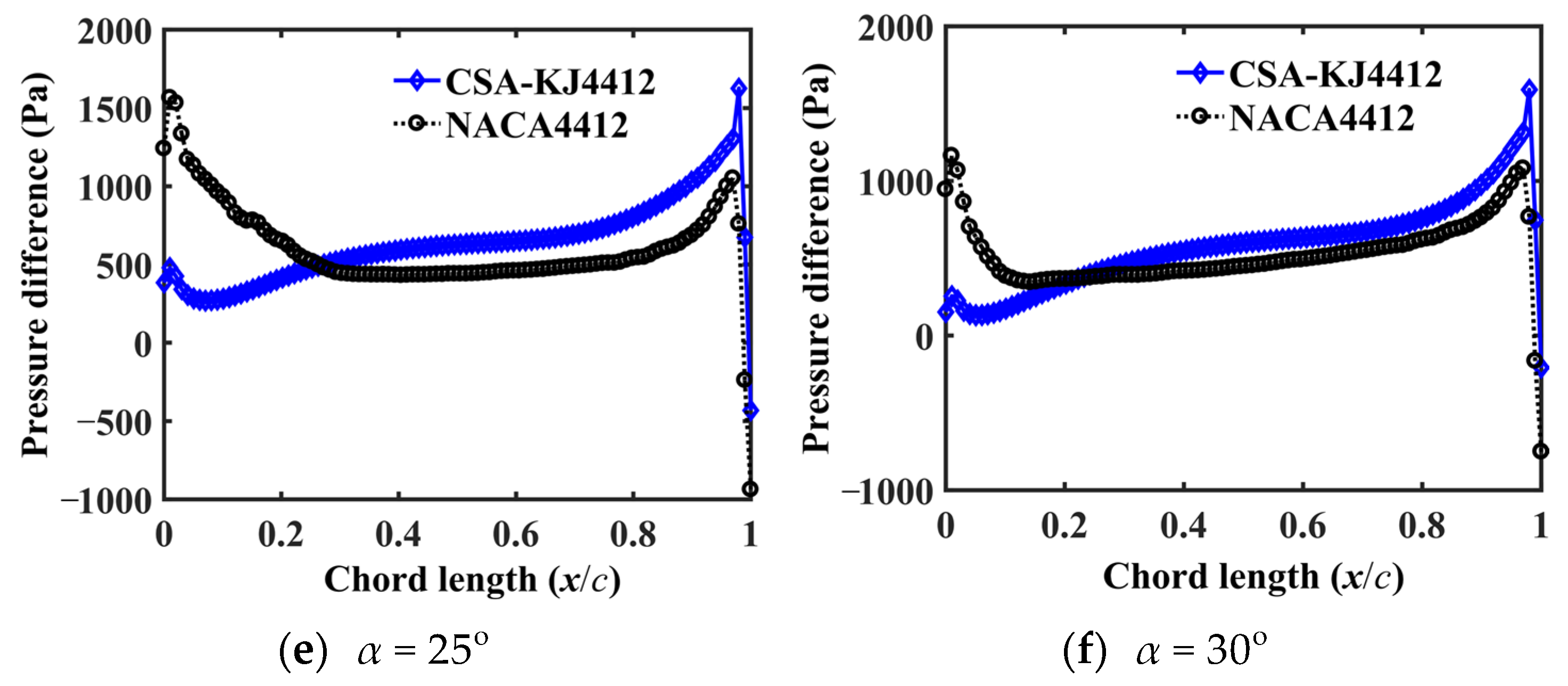
| Coefficients (with 95% Confidence Bounds) | Upper Profile | Lower Profile |
|---|---|---|
| −1.245 (−1.817, −0.6729) | 0.8172 (0.1928, 1.442) | |
| 2.655 (1.616, 3.693) | −1.769 (−2.897, −0.6417) | |
| −2.201 (−2.781, −1.622) | 1.318 (0.6933, 1.943) | |
| 0.7751 (0.6769, 0.8732) | 0. 3461 (−0.4507, −0.2415) |
| Cells | Grid Growth/% | Lift Force | Absolute Relative Error/% | |
|---|---|---|---|---|
| FL/N | ||||
| Grid 1 | 3072 | - | 6578.3 | - |
| Grid 2 | 4176 | 35.94 | 6253.6 | 4.94 |
| Grid 3 | 6384 | 52.87 | 6327.1 | 1.18 |
| Grid 4 | 9024 | 41.35 | 6367.9 | 0.64 |
Disclaimer/Publisher’s Note: The statements, opinions and data contained in all publications are solely those of the individual author(s) and contributor(s) and not of MDPI and/or the editor(s). MDPI and/or the editor(s) disclaim responsibility for any injury to people or property resulting from any ideas, methods, instructions or products referred to in the content. |
© 2023 by the authors. Licensee MDPI, Basel, Switzerland. This article is an open access article distributed under the terms and conditions of the Creative Commons Attribution (CC BY) license (https://creativecommons.org/licenses/by/4.0/).
Share and Cite
Zhang, J.; Guo, W.; Zhang, P.; Ji, H. Optimizing Airfoil Aerodynamic Characteristics by Using Proposed CSA-KJ Method. Appl. Sci. 2023, 13, 924. https://doi.org/10.3390/app13020924
Zhang J, Guo W, Zhang P, Ji H. Optimizing Airfoil Aerodynamic Characteristics by Using Proposed CSA-KJ Method. Applied Sciences. 2023; 13(2):924. https://doi.org/10.3390/app13020924
Chicago/Turabian StyleZhang, Jianping, Wenbo Guo, Pengju Zhang, and Haipeng Ji. 2023. "Optimizing Airfoil Aerodynamic Characteristics by Using Proposed CSA-KJ Method" Applied Sciences 13, no. 2: 924. https://doi.org/10.3390/app13020924






